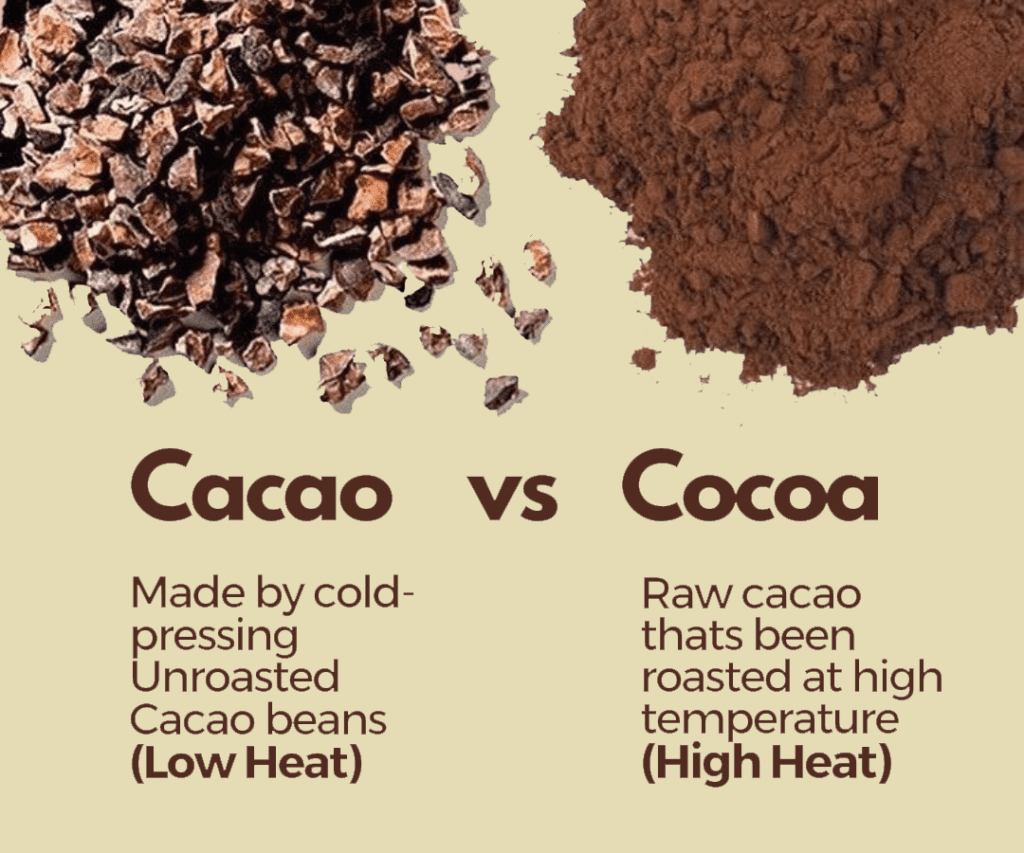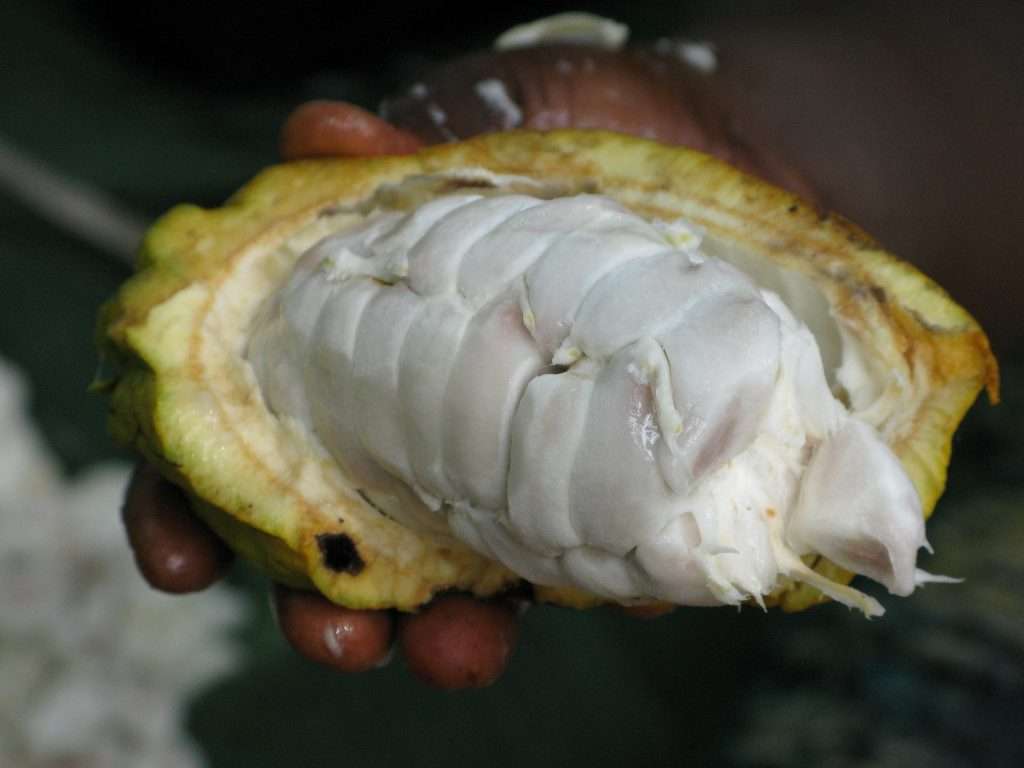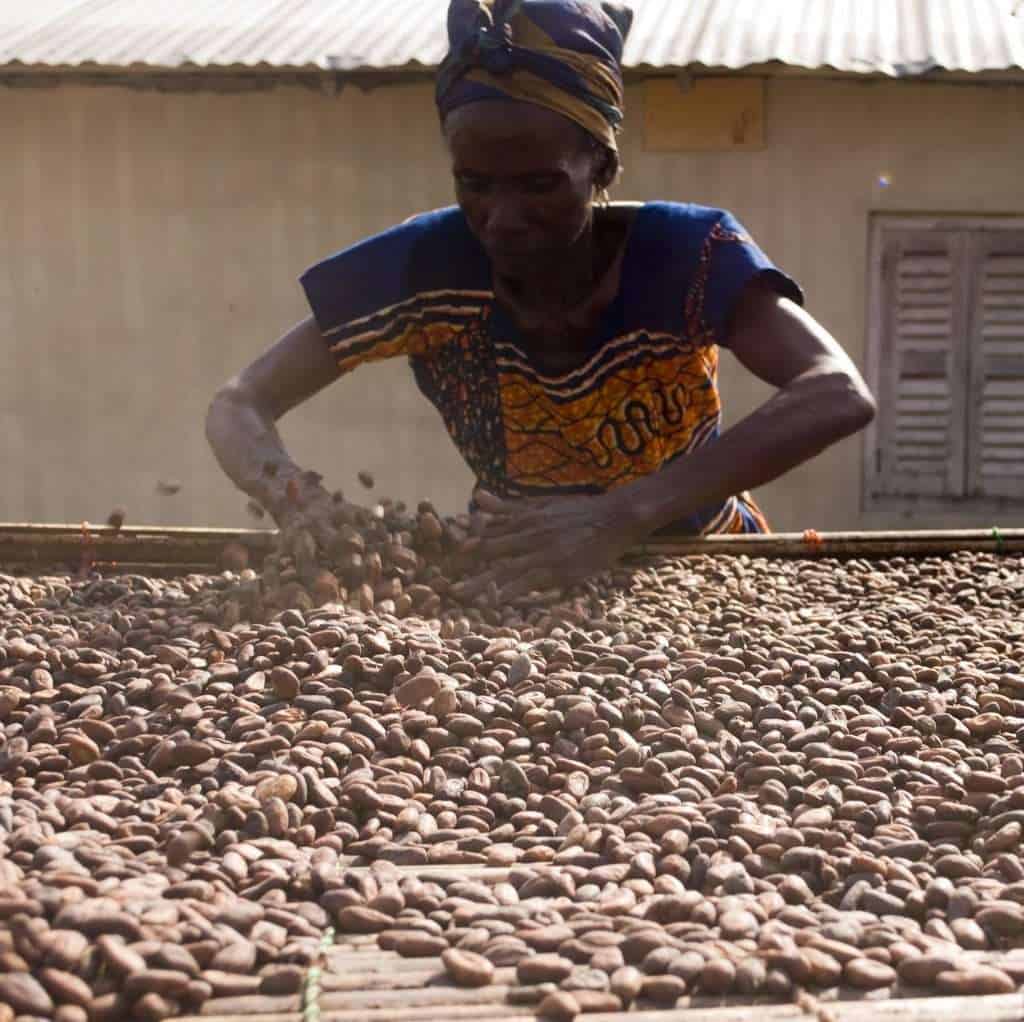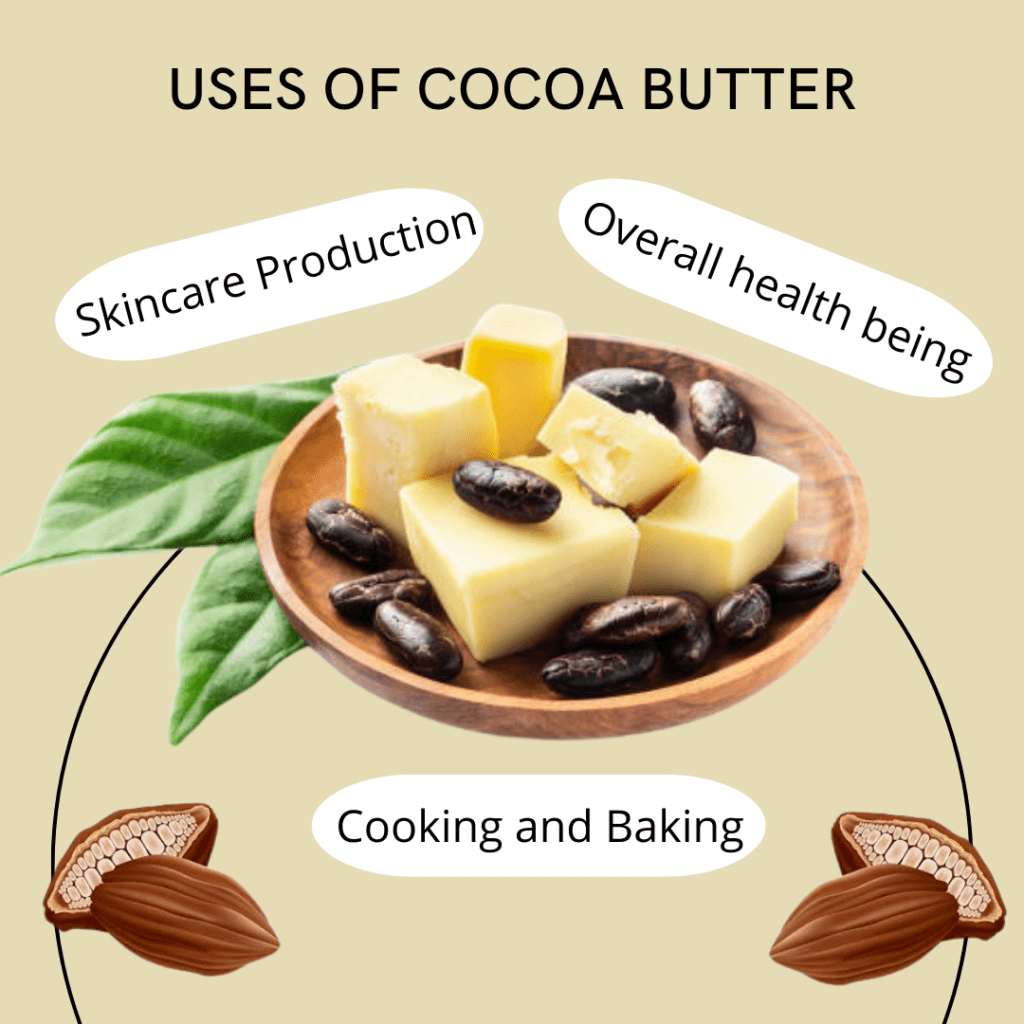This is our review of cacao butter vs cocoa butter.
Are they different?
There are a lot of sources that state that cacao butter and cocoa butter are the same. This is fairly true.
Cacao and cocoa butter are both extracted from the Theobroma beans, which makes them the same, but their process of extraction is different, which confuses people about whether they’re the same.
Cacao butter is extracted through cold processing, which makes it retain its nutrients 100 per cent. In fact, the production process doesn’t exceed 46 degrees Celsius. As such, cacao butter is raw and unrefined.
However, cocoa butter is processed at high temperatures, making it lose some of its nutrients and therefore less than 100 per cent raw.
While cacao butter is more nutrients dense than cocoa butter, they are both used interchangeably.
Hence the only difference is the extraction process.

Refined vs unrefined cocoa butter
While shopping, you might come across cocoa butter labelled either raw or refined.
Cocoa butter meant for the production of skincare products is mostly refined to remove the strong cocoa aroma and colour. It remains stable at room temperature and is rich in monounsaturated fatty acids.
With edible cacao butter, used mostly in food recipes like chocolate, the butter is unrefined or raw with its 100 per cent nutrients intact.
To know which is raw or unrefined before a purchase, read the label on the products. Be careful though, because some retailers may label a refined product raw.
What is cocoa butter?
Cocoa butter is the yellowish fat extracted from Theobroma beans after the cocoa powder is removed. Although saturated, it is a healthy fatty acid with many skincare and nutritional benefits.
Through its processing, either cold or with heat, raw cocoa butter may also turn out creamy in colour, possessing a sweet aroma akin to chocolate, and is the only fat found in chocolate, due to its unique feature of being brittle at temperatures below 25 degrees Celsius.
It is mostly solid at room temperature but melts at 35-37 degrees Celsius. Cocoa butter is mostly used as skin moisturizers globally, yet its health benefits are influencing its use in the kitchen as well as in the food processing industries.
Cocoa butter serves, also, a moisturizer for dry hair, working on African strands to make them easier to comb.
How is cocoa butter processed?
1. Extracting cocoa beans from the pods
According to Fanny et al, to extract cocoa butter, you first harvest the pods at maturity. The amount of cocoa beans you harvest depends on the amount of cocoa butter you need.
Then you open the pods to remove the beans carefully, placing them in a basket. The husks of cocoa are a good source of compost for plants. It is advisable not to wait more than four days before opening the pods.

2. Fermenting the cocoa beans
When you open the cocoa beans pods, it’s time to ferment them. Mostly, you ferment the beans using wooden boxes that have holes at the bottom. The beans are placed in the wooden boxes placed above floor level to keep the beans warm.
Because the beans are fresh, as they ferment, juices drip to the bottom and may cause the beans to rot. This is why it is important to make holes at the bottom of the wooden box so that the drips can flow out of the box.
Nevertheless, some farmers prefer to heap the cocoa beans on a dry flat surface, covering them with banana leaves and turning them a few times a week to ferment. The disadvantage of this process is that the drip of the fermenting cocoa beans stays in the heap and may result in rot.
The best method to use in fermenting cocoa beans, therefore, is the wooden box, however, you need to change the boxes every two days after stirring the cocoa beans.
Now cocoa beans go through a fermentation procedure because cocoa beans contain a seed coat, a germ, and a kernel. The fermentation process destroys the seed coat, and germ and gives the kernel a good taste.
3. Drying the cocoa beans
After you ferment your beans, you then dry them. There are two ways to dry cocoa beans; through the scorching sun or by roasting using fire.
To use the sun method, spread them on large boards or flat surfaces raised one meter above ground level. Keep the layer of cocoa beans as thin as possible, less than four centimetres thick.
Keep watch, stirring the beans often so the bottom can expose you to the sun too. This may take between five to ten days to dry.

To use the fire method, spread the cocoa beans on a concrete slab and place them above the modern drier. The modern dryer is built with a hollow space beneath it. The light fire underneath the modern dryer heats the concrete slab.
The fire should not be too hot as to burn the cocoa beans. Make sure you stir often to achieve balance or even.
The modern dryer method is mostly used in cocoa-growing regions where the weather is often moist, and as such, using the sun method does not dry the cocoa beans well.
Drying cocoa beans makes them less moist which ensures the purest extraction of cocoa butter.
4. Sorting the dried cocoa beans
After drying the cocoa beans, they need to be sorted by separating the broken beans, the flat beans, the germinated beans, and mouldy beans.
This process is necessary to keep only good dried cocoa beans.
5. Grinding the cocoa beans
Dried cocoa beans are then finely ground, and pressed so you can obtain cocoa butter. There are also two methods used in grinding cocoa beans for cocoa butter.
One method is through warming the ground cocoa beans to be able to press them warm. This method is easier although it does not obtain raw cocoa butter.
Contrariwise, you can cold press the dried cocoa beans to obtain cocoa butter. This cocoa butter is raw cocoa butter with all the ingredients intact.
Cold pressing cocoa beans can either be done by pressing the whole cocoa beans to extract cocoa butter or by grinding the cocoa beans to a pulp and then pressing the pulp to extract the butter.
Whatever cold pressing method you use results in the same purest quality of cocoa butter, however, grinding guarantees maximum removal of raw cocoa butter.
Mostly, factories adopt the extraction of cocoa butter method, but you can use the process at home if you have the right equipment and tools. Moreover, you can always get raw cocoa butter to make homemade cocoa butter for your skincare.
What is cocoa butter used for?
While cocoa butter is mostly used in chocolate production, you’ll find cocoa butter used for other purposes. Cacao butter vs Cocoa butter; same, is edible, so you’ll find it in most cooking recipes.
It is also naturally emollient, and because of that, it’s frequently found in beauty cosmetics.
You can find cocoa butter in most soaps, lip balms, moisturizers and skin creams. Cocoa butter products can soothe irritated skin and heal skin that’s rough. It works wonders on dry affected by eczema.

The following are some uses of cocoa butter;
1. For Cooking and Baking:
You may utilize cocoa butter to make a wide range of chocolates, including dark, milk, and white chocolate varieties. Although the name butter, cocoa butter is purely vegan and does not contain dairy properties.
The rich nutrients in cocoa butter with its naturally scented chocolate aroma make it unique for cooking purposes. For use as oil, first melt it to obtain the liquid, because cocoa butter is solid at room temperature.

Cocoa butter also has a high smoke point making it suitable for roasting and other high-temperature cooking.
2. For Skincare production:
It Reduces dry skin problems
People with dry skin problems can use raw cocoa butter because of the ease of absorption into the skin and firm texture, significantly improving the appearance of the skin.
It contains saturated fats
Cocoa butter consists primarily of saturated fats, including oleic acid palmitic acid and stearic acid which act as an emollient. When applied to the skin by lotions, creams, or bath oils, emollients can soften the skin and help it improve its texture.
It Fades dark spots and skin
Daily use of cocoa butter will help moisturize, smooth, and soften rough and dark elbows, knees, hands and feet, especially for black or Africans. Regular use will also help to fade the darker skin on these areas, giving elbows and knees a more even skin tone.

3. For overall health being
Serves as an anti-inflammatory moisturizer
Cocoa butter is a moisturizer that offers relief to skin plagued with burns, dryness, eczema, stretch marks and irritation. It is believed to enhance the body’s immunity by promoting relaxation, and it is gentle enough to use for masseuse and infection treatment without causing further sensitivities.
Cocoa butter contains Oleic Acids
Also known as Omega 9, oleic acids in cocoa butter help to maintain the softness, and glow of the skin while nourishing the agility of the skin. Oleic acid is the ingredient that stimulates the growth of thicker, stronger and longer hair for all hair types while reducing dandruff
Among others, omega 9 reduces premature ageing and skin wrinkling, preventing joint pain and stiffness.
Most commonly, it helps to keep firm cocoa butter from melting in unfavourable conditions.
It contains Stearic acid
Stearic acid in cocoa butter is known for purging dirt, sweat, and excess sebum from the skin and hair. Serving as cooking oil, stearic acid in cocoa butter serves as an emulsifying agent that binds water and oil, while helping products steady when stored for a long time.
Stearic acid protects the butter from melting too, by providing a compacted brittle. It likewise conditions hair from damage and softens skin.
Cocoa butter has a decent Palmitic acid
The presence of palmitic acid, also known as saturated fatty acid in cocoa butter acts as an emollient that helps to soften the skin, protecting the skin from being dry by forming oily moisture.

How to store cocoa butter?
When properly stored, cacao butter has a long shelf life. Keeping cocoa butter in a cool, dark place like the pantry or cupboard will improve its longevity.
Cacao butter should not be kept in a hot car or exposed to direct sunlight. Remember that cocoa butter is a solid at room temperature, but it will melt when subjected to heat.
Where to buy raw cocoa or cacao butter
Remember Cacao Butter and Cocoa Butter are the same products. Raw cacao powder and cacao butter are readily available at most health food shops and some major supermarkets.
Raw chocolate can be found at health food shops, variety stores, or online.
Facts about cocoa butter
- It is used to make chocolate to keep it firm, and consistent and only melts once in the mouth.
- Cocoa butter is a healthy fat. Although unhealthy fats tend to be solid at room temperature, cocoa butter is a unique healthy fat that remains brittle even in hot weather.
- Cocoa butter medically boosts hormones and the immune system whether used in cooking or chocolate.
- It effectively raises dopamine and serotonin.

Frequently Asked Questions
Q: Can Cocoa Butter Be Used In Baking?
A: Cocoa butter is used for thinning chocolate and making chocolate coatings. It is seldom used in baking applications because it hardens at room temperature, making it less than ideal for creaming methods unless combined with other liquid fats.
Q: Can You Replace Cacao Butter With Olive Oil?
A: When you melt the cocoa butter, you get theobroma oil. This oil can replace the use of olive oil. At room temperature, this oil solidifies just like coconut oil. But when it’s applied to your skin, cacao butter melts like a lotion and is quickly absorbed into your pores for instant moisturizing. But you can also eat cacao butter to reap its many health benefits.
Q: Can I Refrigerate Cocoa Butter?
A: So instead of the fridge: Store it in a cool, dry place. You can use a tight container to store it and keep it from direct sunlight.
Q: Can I Eat Raw Cacao Butter?
A: Yes, cacao butter is edible. However, you cannot eat it alone; you’ll have to mix it into sweet and savoury recipes to enjoy it whole.
Q: Which Is Better; Cacao Butter Vs Cocoa Butter?
A: Since the only difference is the processing, both cacao and cocoa butter are the same and contain the same health properties.
Q: What Is Cacao Butter Used For?
A: Cacao butter imparts a rich flavour and silky-smooth consistency, making it the perfect base for chocolate making without the need for dairy or cream. It can be used in cakes, bliss balls, tarts, ‘ice-cream’, smoothies and basically anything you want to add creamy cacao goodness to.
Q: Is Cacao Butter The Same As Cocoa Butter?
A: Cacao Butter. Raw cacao butter and cocoa butter are essentially the same, except that the manufacturing process of raw cacao butter is slowed down to ensure that the temperature does not exceed 115 F (about 46 C).
Q: Which Is Healthier; Cacao Or Cocoa Butter?
A: Cacao is thought to be the highest source of antioxidants of all foods and the highest source of magnesium of all foods. Cacao powder contains more fibre and calories than cocoa powder since more of the nutrients from the whole bean are still intact.
Q: What Is The Difference Between Cacao And Cocoa Butter?
A: Cacao butter is the pure, cold-pressed oil of the cacao bean. Raw cacao butter production doesn’t exceed 46 degrees Celsius, whilst cocoa butter might undergo some heating during the pressing process. Raw cacao butter is more nutrient-dense but otherwise, they are totally interchangeable.
Now it’s your turn!
Cacao butter vs Cocoa butter can be used interchangeably because they are the same product. The only difference is the technique used in extracting either.
Both cacao and cocoa butter are used in cosmetic or beauty products, culinary recipes and hair products.
Make sure to check product labels to be sure you’re buying raw cocoa butter if that is what you are looking for.


